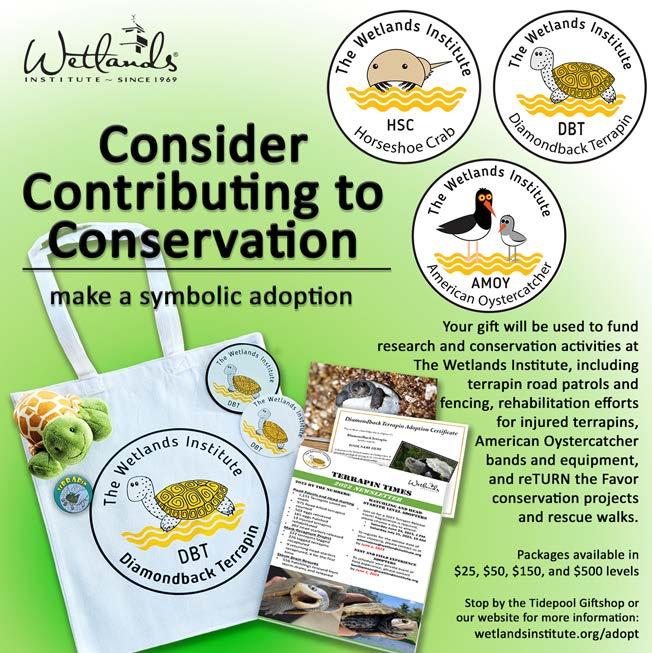The Collective Spirit of Environmental Education
by Brooke Knapick, Director of Educational Program Development
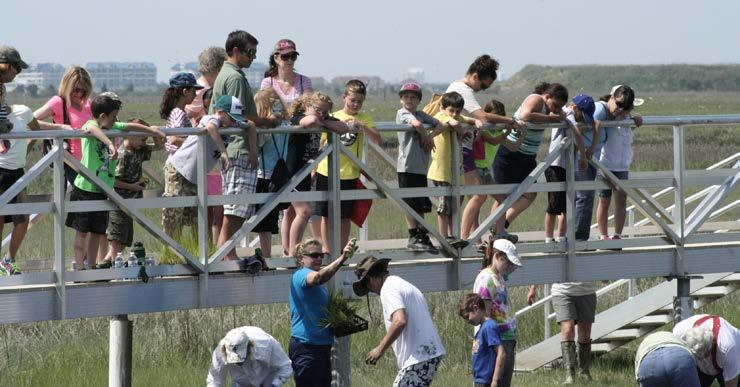
What inspired you to teach environmental education? The answer to this question is as varied as the people answering it. For me, the answer is simple: I teach environmental education for a chance to observe the spark. The spark you see on a person’s face when you know they have made a genuine connection to their environment.
In pursuit of the spark, I have created and led innovative environmental education programs at the Dunes Learning Center, Northern Illinois University’s Lorado Taft Field Campus, and the Indiana University, Purdue University Indianapolis Center for Earth and Environmental Science. Then life brought me here to The Wetlands Institute, where for nearly 13 years I have had the honor and privilege of stewarding a vision and refining a structure that ignites the spark in the children and adults.
The Institute offers one of the best
outdoor classroom environments in South Jersey. Each year, upwards of 16,500 children and young adults, from over 170 local schools and organizations participate in education programs. With each program, we reach into classrooms and homes in New Jersey, New York, Pennsylvania and Delaware, sharing the wonders of marine life with the local community.
All our Environmental Education Field Trip Programs emphasize hands-on learning and the scientific method. School groups visiting the Institute range in age from Kindergarten to High School, and experiences include exploring the unique ecosystem of the salt marsh, learning about the food web, examining the life and conservation efforts of the diamondback terrapin, visiting the beach, and discovering the characteristics of a wetland by performing different experiments. With our newly launched Undergraduate
Environmental Education Field Trip Program, we are expanding these hands-on, feet wet experiences to college-aged students. By the end of this immersive field experience, students are left with a deeper understanding of wetlands and/ or barrier beach ecology and these complex ecosystems.
While a visit to the Institute is sure to be a memorable experience, our Traveling Environmental Education and Group Outreach Programs bring all that the Institute offers to schools, libraries, campgrounds, and local youth organizations across the tri-state area. After several years of dedicated effort, we are proud to now offer a full suite of Adult Outreach Programs that feature more in-depth content tailored to an adult-only audience. As we grow our in-person programs, our Virtual Wetlands Experience continues to inspire and foster a virtual connection to the natural world with more than 15,350 visitors since 2020. We remain dedicated to our mission of teaching environmental education, enabling individuals to form a genuine connection with their environment. As we journey together toward the future, we remind ourselves, we teach environmental education for the chance to observe the spark. I hope you will join us in celebrating the nearly 55 years of the spark here at The Wetlands Institute and consider investing in the future of educational achievements yet to come.
Deborah A. Hays, Chair
James Donohue, Vice-Chair
Hank Schellenger, Treasurer
Annie Ulichney, Secretary
Raymond Burke
Timothy Jon Clay
John Flynn
William Hankowsky
Margaret McAllister
John Millar
Staff
Leadership
Jeannie Morris
Liz Thomas
Jon Tullis
Amy Welsh
William Wermuth
Francis J. White III
Dr. Lenore Tedesco, Executive Director
Dr. Lisa Ferguson, Director of Research and Conservation
Jim Frick, Director of Finance and Operations
Brooke Knapick, Director of Educational Program Development
Research & Conservation
Julie Blum, Research Scientist
Samantha Collins, Research Scientist
Meghan Kolk, Conservation Scientist
Bailey Sanders, Research & Conservation Coordinator
Brian Williamson, Research Scientist
Education
Francesca Jacobs, Environmental Educator
Abbygayle Liles, Aquarist/Environmental Educator
Erin Rawls, Outreach Coordinator
Development & Communications
Leah Satterfield, Development Associate
Finance
Terrie Campbell, Finance Administrator
Christine Whaley, Finance Analyst
Administration
Mary Beth Ciccarone, Administrative Coordinator
Kimberly Dmytro, Tidepool Shop Manager
Michael Fridmann, Facilities Manager
Visit Us
Hours: Starting September 20, open
Saturday and Sunday 9:30 to 4:30. Check our website for Holiday Hours.
General Admission: Members: Free.
Non-members: $12 Adults, $10 Children 4-12.

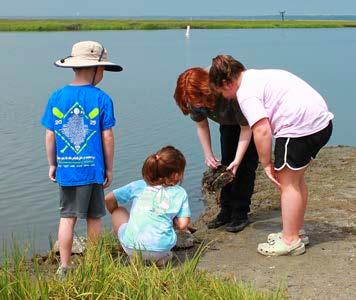
Marsh M usings
by Dr. Lenore Tedesco, Executive Director
A season to celebrate
How did that happen? Another summer in the books! They seem to go faster and faster, but the waiting time for summer to arrive seems to go slower. I’m not sure how that works. I hope it was as amazing for you as it was for all of us at The Wetlands Institute. Summer is our high energy, everything is moving fast time, but when I pause to take a deep breath and reflect, I can honestly say we are having a great year – and all of you have had a role to play so far! Our education and visitor programs have been extremely well attended, with the Summer Nature Program at capacity. This foundational program has proven to be a gateway to exploration and discovery that leads to multigenerational connections to the Institute. I am so proud of this program and the amazing staff that give so much to make it truly remarkable. The Luing Family Internship Program has just wrapped up, and we all benefited from the tireless efforts of this year’s undergraduates. They contribute so much to the organization and in turn, learn so much about themselves and many chart a course for their future through the program. The staff teams that work with them invest so much, and they too receive so much. They are amazing.
Important moments of celebration came at our annual donor open
house at the end of June, when we celebrated and honored you. It is truly a wonderful event where we get to thank each of you for your contributions that help drive our mission. At the end of July, we hosted our 11th annual Summer Celebration. We had a fun and exciting evening with live music and a lively silent and live auction. It’s a night where we make new friends and enjoy time with longtime supporters. We had a recordbreaking night and are excited to continue to have positive impacts that drive lasting change. Thank you for celebrating with us.
As we slide into fall, our attentions and efforts shift to grant writing, reporting, and planning for the Institute’s future. Our planning efforts for our marsh campus and marsh projects are picking up dramatically and we are making great strides. We will continue to provide updates as our plans take shape. Stay in touch, and we hope to see you again soon.

Where Did The Oysters Go?
by Ray Burke, Wetlands Institute Trustee
For me, one of the most interesting aspects of growing up on Jenkins Sound was the opportunity to learn about shellfish. My family particularly enjoyed harvesting the native oysters (Crassostrea virginica), which I found in brackish water at the intersection of Gravelly Run Creek and Jenkins Sound. Oysters favor areas with this input of freshwater and grow best in brackish waters that are less salty. The area, known to locals as Shell Bay, contains the remains of heaps of discarded shells, referred to as shell middens, that were originally deposited by Lenape Native people who fished the area thousands of years before Europeans arrived. Much of these middens have been silted over in recent years, but they were still quite apparent when I was a child.
As kids, my brother, sister, and I would walk the area at low tide and collect live oysters, which we would relocate to our bed at Gravelly Run. In those days, the traditional period for oyster harvesting was any month with an “R” in it.
Over the years, the bed became quite extensive, but by the time I was a teen in the 1970s, there were growing threats from agriculture and housing development on the mainland and barrier islands that was creating bacterial contamination in the back bays, making the shellfish periodically unsafe for human consumption. Although the beds appeared to be healthy and water samples of the creek were not alarming, when I left for Lafayette College in 1971, most of the area was closed to shellfish harvesting.
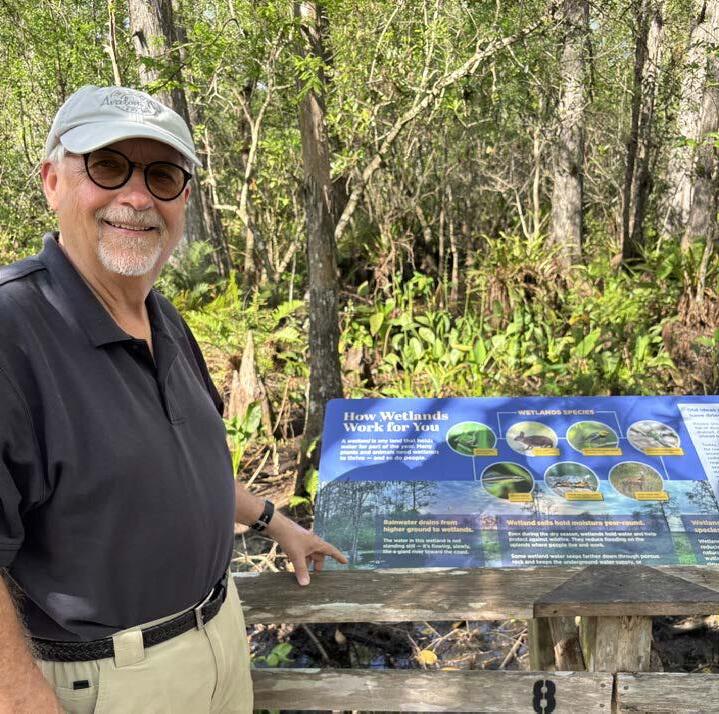
1974 because the cold snap had frozen the brackish water flowing across the oyster bed at low tide. As the tide rose, it lifted the oysters from the bed, which then floated away with the ice.
As I headed home from school for winter break in 1974, I was expecting my mom might be able to make her oyster stew for the holidays. As I recall the later part of December that year had been unusually cold. There were signs of ice on the meadows visible from the Garden State Parkway. On my arrival home, I immediately hiked across the marsh to inspect the oyster bed and it was gone! Hardly a trace of the bed remained. There was no oyster stew for me in the winter of
Today oysters are rare in the back bays in our area largely because the back bays have become less brackish. This is due in part to less fresh water flowing into the bay as a result of the development of the communities that border the bays but also because of rising sea level.
Author’s Note:
The Wetlands Institute has actively researched and advocated for improvements in water quality and species preservation in our back bays. Today, many shellfish areas are once again open to legal harvesting especially hard clams.
Act Local, Think Global Wetlands Style
by Dr. Lenore Tedesco, Executive Director
Cape May County is a remarkable place. That simple statement barely scratches the surface of how important a place it is. Our location at the southern tip of New Jersey, on a narrow peninsula nestled between the Atlantic Ocean and Delaware Bay, boasts remarkable natural areas and an incredible diversity of wildlife and lies along one of the most incredible flyways in the world. The incredible foresight that preserved natural areas here, led notably by Wetlands Institute founder Herbert Mills, helped cement this place as globally significant. The Atlantic flyway is essentially a vast highway for migratory wildlife that connects them to breeding and wintering grounds that stretch from the high Arctic of Canada all the way to the southern tip of South America. For other species, this is their home. The rich marshes, beaches, and shallow bays are crucial for their wellbeing, whether they are passing through on their way elsewhere, coming here for the summer to breed, the winter for the milder climates, or year-round residents: this place is their lifeline. So, what happens here matters dramatically in the well-being and conservation of many species.
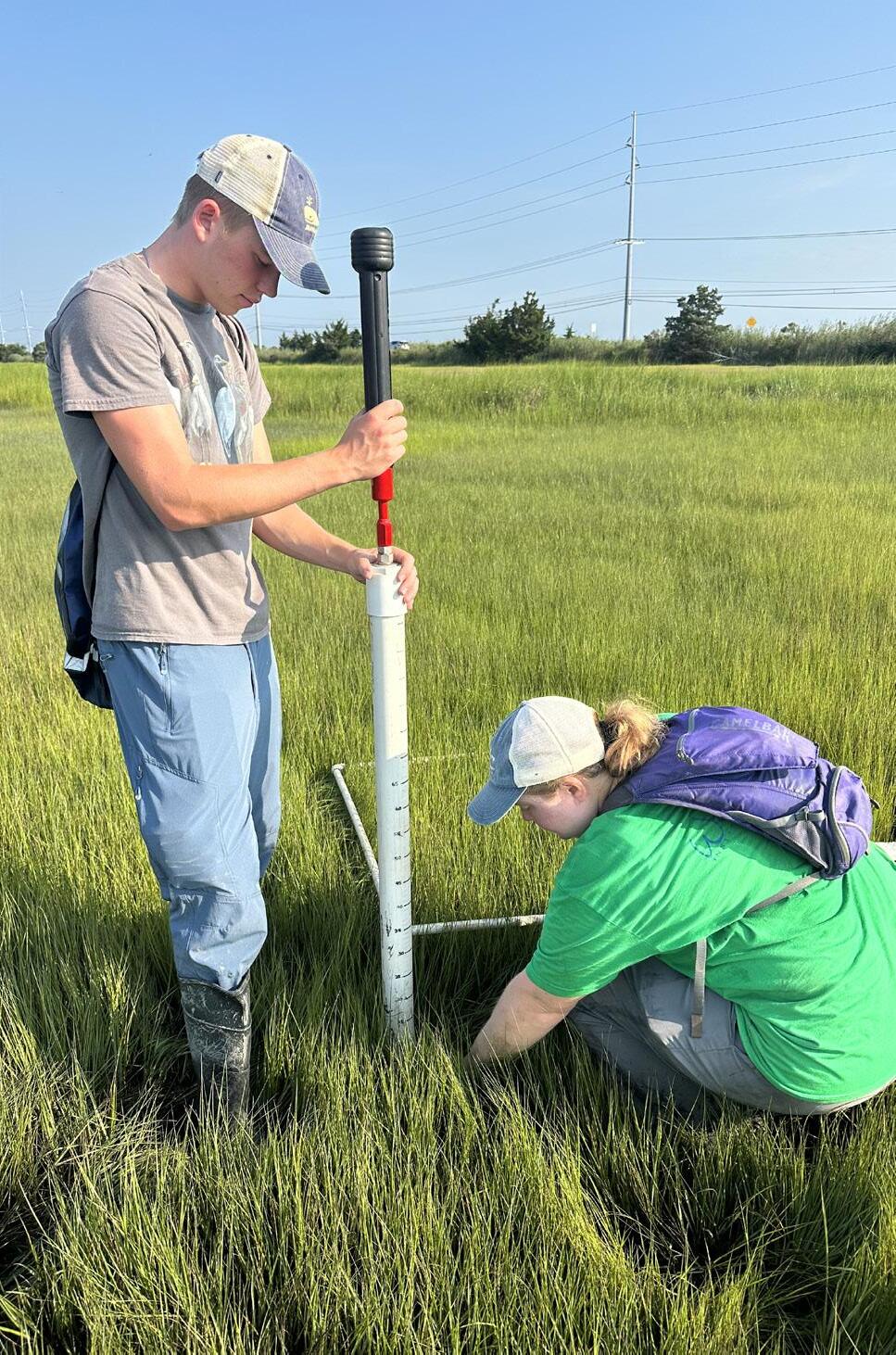
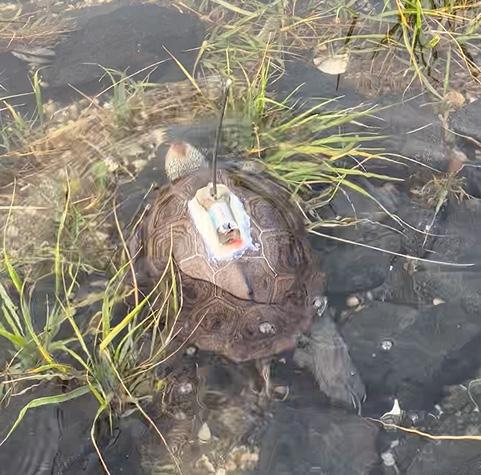
Many of these species face increasing threats and population decline. The Research and Conservation Department focuses on several of these important species, including diamondback terrapins, colonial beach nesting and wading birds, and American oystercatchers, supporting them through research, habitat protection, and threat mitigation. The work we do to understand their needs, habitat use, and response to both climate change and habitat restoration projects is making a difference far and wide. Our research scientists are members of important regional and national scientific steering committees and working groups, and bring their knowledge to bear to help guide conservation plans and practices nationally.
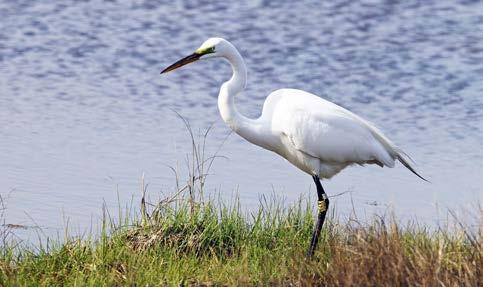
The Institute itself is a hub of activity for visiting scientists, professional workshops, webinars, technical resource manager trainings, and field trips so that everything we learn is quickly and effectively translated to guide best conservation practices. Implementing best conservation practices locally is then another pillar in our work to drive global change – change that ripples out from our roots, far and wide.

Luing Family Internship Program
Educators Leading the Way
by Brooke Knapick, Director of Educational Program Development
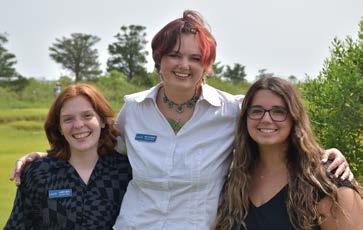
This year’s Luing Family Internship Program Environmental Education Interns spent 12 weeks leading public education programs, while immersing themselves in the unique environment of the surrounding salt marsh and barrier islands. They worked hard and through it all developed skills needed to continue their careers in environmental education. Each year, interns are asked to develop and implement an education project of their choosing that is personally and/ or institutionally beneficial. The deliverables from their projects
leave a lasting impact on The Wetlands Institute and we hope you’ll stop by to see their education initiatives in action.
Wiley Koskinen (Goucher College) directed and produced a Why You Should Care participatory video documentary that showcases part of the work done at The Wetlands Institute, and how young adults can contribute to conservation efforts. Specifically, it highlights the research and conservation work of the Coastal Conservation and Research Program Interns as well as the Environmental Education Interns and their various public programs. Alyssa Margerum (Kutztown University) created a tide tank in the Secrets of the Salt Marsh Aquarium that will fluctuate in water level to show what it looks like during high versus low tide, along with a series of posters discussing the biological and chemical
differences between high and low tide as well as the impact climate change has on the tide. For younger audiences to explore this concept, there is an interactive bitmoji space on the Virtual Wetlands Experience. Aubrey Smith (Montclair State University) updated the Plankton Creature Feature to expand the meroplankton section, adding slides on crabs, horseshoe crabs, fish, and sea stars plus the addition of a short interactive quiz, updated speaker notes and enhanced educational materials featuring life cycle diagrams for highlighted species.

Meet the Coast Conservation Research Interns
by Bailey Sanders, Research and Conservation Coordinator
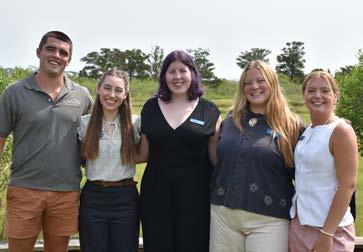
This summer, five Coastal Conservation Research Program interns brought their energy, curiosity, and dedication to advancing our understanding of coastal ecosystems. Throughout the season, they participated in long-term monitoring of diamondback terrapins and coastal birds, conducted independent research, honed field and lab skills, and formed lasting connections. We were especially fortunate to welcome back a second-year
intern who helped mentor new participants and enrich our collective efforts.
Returning intern Mary Castellani explored the foraging patterns of American Oystercatchers on Delaware Bay beaches and Atlantic coastal marshes. She also documented human disturbances at foraging sites, which can help inform restoration planning and disturbance thresholds in key foraging areas during the breeding season.
Katelyn Seay analyzed vegetation succession and zonation trends of six focal plant species (Spartina patens, Iva frutescens, Juncus gerardii, Phragmites australis, Baccharis halimifolia, and Distichlis spicata) on elevated nesting habitat at Ring Island. Her findings offer valuable insight into marsh restoration practices, particularly in
determining optimal elevations for vegetation that supports nesting wildlife.
Kristen Kallok studied the habitat use and home range of eastern box turtles on The Wetlands Institute property. Her project sheds light on how small habitat fragments may contribute to the species’ survival in areas impacted by human development.
Sarah Davidson investigated the environmental factors influencing diamondback terrapin nest site selection at TWI. Her work supports future efforts to restore, replicate, and protect suitable nesting habitats.
Joey Brace examined repeat nesting behavior in diamondback terrapins at TWI from 2020 to 2025, helping us build a clearer picture of nesting patterns and site fidelity over time.

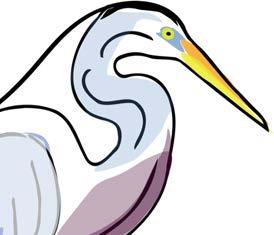



Archer & Greiner P.C.
Avalon Flooring
Burke Subaru
Hays Sheet Metal
AKRF
Jeffrey H. and Lee Alderton At the Shore
Atlantic Capes Fisheries
Avalon Home and Land Owners Assn.
Brandywine Developers, Inc.
Brown & Brown Insurance
Ray & Ellen Burke
Drs. Timothy & Rosemary Clay
Closets & Blinds by Satori
Cold Spring Fish and Supply Co.
Concentus Wealth Advisors
CrossCountry Mortgage, LLC
- Silver Sponsors -
The Mottola Group PSEG
RJ Soens Group / Compass RE
Seven Mile Times
Bronze Sponsors -
D.L. Miner
James J. Donohue & Carol A. Mager
Hafetz & Associates
Halliday Financial
Lois & Barry Hamilton
Deborah & Michael Hays
Lucky Bones
Lund’s Fisheries
Painting by Pearce
PMI Saltwater
PM Pools & Spas
RBC Wealth Management / The Boland Investment Group
John & Amy Swanson
Jon Tullis
Washington Inn
Rockwell Development Group
Scarborough Marine Group
Hank & Julie Schellenger
Schultz & Williams
ShopRite of Hunterdon County
Sturdy Bank
Lenore Tedesco & Nancy Fribley
Thomas/Boyd Communications
Amy & Philip Welsh
Westside Meats
Vicki Wilkinson & Phyllis Beidler
Laura Wilson & Mark Menting

Autumn Happenings
As the salt marsh grasses fade from green to brown, The Wetlands Institute is open daily from September 2-21, 2025. Unless otherwise stated, all activities are free with admission and occur onsite at The Wetlands Institute. For more information, visit wetlandsinstitute.org/events.
Salt Marsh Safari
11 AM & 2 PM Daily
Watch our award-winning film, Secrets of the Salt Marsh, then join us for an interpretive marsh walk along our elevated walkway and onto the dock overlooking Scotch Bonnet creek!
Creature Feature
12:30PM Monday and Friday
During this live animal presentation, get up close and personal with turtles, fish, crabs, sea stars and urchins, mollusks, horseshoe crabs, or the popular animals of Finding Nemo
Aquarium Feeding
12:30PM Tuesday, Thursday, and Saturday
Help us feed the local marine life! We will open up feeding three times each week so you can see the burrfish eating crabs and the horseshoe crab gobbling shrimp.
Tidepool Shop
The summer season may be winding down but look up in wonder overhead and in the sandy flats, marsh edges and shorelines where migrating birds pause to feed and the last of the late summer blooms prepare for sleep. The seasons may change but the story of conservation, vital research and education goes on year ‘round, and you can forward this story to friends near and far with these delightful cards. Share a migratory moment you witnessed with a loved one, and create a moment of connection and inspiration. These cards are made of recycled papers and soy based inks, right here in the USA. A portion of all sales in The Tidepool Shop support our coastal habitat education programs and groundbreaking research and ongoing conservation projects.
Thank you and see you soon!
Get your feet wet (or wear waders!) as you discover what swims in the back bays. Help us drag a seine net through the water to find crabs, shrimp, fish and more. Catch o’ the Day Wednesday 12:30 PM
Seashell Sunday
12:30 PM Sunday new hours
Seashells at the seashore! Join us to learn all about seashells, how to collect them without harming the environment, and touch an assortment of live mollusks and cool artifacts.
Winter hours and activities start September 22, 2025. Starting then, The Wetlands Institute will only be open on Saturday and Sunday. Please check our website calendar for programming updates as we transition from autumn to winter hours.

A non-profit organization studying, preserving,
A non-profit organization studying, preserving, and protecting wetlands and coastal ecosystems

As a conservation organization, we have a special responsibility to address the global challenges of climate change and sustainability. We are committed to minimizing environmental impacts in all aspects of our operations. Visit our website at wetlandsinstitute.org/about-us/ sustainability/ for more on our sustainability initiatives.

